|
FAQs about Live Rock Hitchhiker/Creature
Identification
25
Related Articles: Live
Rock, Reef Systems, Refugiums,
Related FAQs: Live Rock, Answering
Some LR FAQs by James Fatherree, LR
Hitchhiker ID 1, LR Hitchhiker ID
2, LR Hitchhiker ID 3, LR Hitchhiker ID 4, LR Hitchhiker ID
5, LR ID
6, LR ID 7, LR ID 8, LR ID 9,
LR ID 10, LR
ID 11, LR ID 12, LR ID 13, LR ID
14, LR ID 15, LR ID 16, LR ID17,
LRID 18, LRID
19, LRID 20, LRID 21, LRID 22,
LRID 23, LRID
24, LRID 26, LRID 27, LRID 28, LRID
29,
LRID 30, LRID 31,
LRID 32, LRID 33,
LRID 34, LRID 35,
LRID 36, LRID 37,
LRID 38,
& Non-Vert IDs 1, Tubeworm ID, Polychaete Identification, Live Rock 1, LR 2,
LR 3, LR 4,
LR 5, Curing
Live Rock, Live Rock Selection,
Shipping/Moving, Placement, Lighting, Water Quality, Live Rock Studies in Fiji Collaboration
& Charts, Copper Use, Marine
Landscaping, Marine Biotope,
Sumps, Refugiums, Faux
Rock,
|
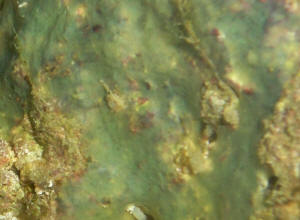
|
|
Strange White "Hair" on Rocks
7/26/10
Hello Wet Web Crew,
<Jenny>
About two months ago, I bought 3 pieces of "base rock"
that looked like white manufactured rock, even though it was said
to be "Reef Rock" (from reefcleaners.org). Silly
enough, I cycled it in water for two weeks, just in case there
was anything living on it that could be harmful to my
aquarium.
Anyway, to get to the point, during the last week, (only) these
three rocks have sprouted what looks like 1/4" clear hairs
everywhere on them (see photo). The "hairs" sway in the
current and almost look like a velvet fuzz.
<Good desc.>
My tank has been established for 2+ years, without any new
additions in the last few months except these rocks. Any idea
what the "hair" is and if it could be harmful to my
fishes and corals?
<Is likely an algae or mix of algal and Protists... not
harmful... and will "go" of its own accord in
time>
Also, I've checked all of my tank conditions and all seem
fine (Nitrates are close to 0 most of the time due to skimming,
water changes, etc, so I am in doubt of it being a bad algae even
though it could be).
Any help in identifying this would be greatly appreciated!
-Jenny
<A microscopic examination would very likely be more
definitive, but barring such investigation, I would not worry.
Bob Fenner>
|
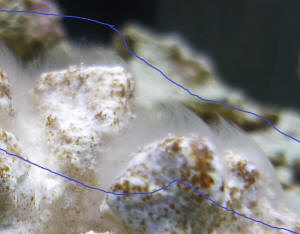 |
|
live rock hitchhiker id 7/25/10
Hello Wet Web Crew,
<BD>
I recently had some Fiji live rock shipped to my home (pretty hot
and cooked looking by the time it got here), and have several
large 3-4 inch patches of some light brown 'encrusting'
stuff I'm hoping you can identify.
<The first appears to be some sort of Brown algae (a
Phaeophyte), though it could be sponge material... the second is
almost assuredly Lobophora, another Brown... see here: http://www.wetwebmedia.com/brnalgae.htm
I peeled some off of the rock and took magnified picture of the
underside as well. I'm not sure whether to scrape it off
entirely or leave alone.
<I'd remove what comes off easily>
It's in qt now so want to decide before it's ready to go
in display tank.
My worry is that it's some type of unwanted pest like fire
coral .....
<Nah, just biomass that will add as pollution to your tank,
water>
Thanks for your observations,
Wendy
<Welcome! Bob Fenner>
|
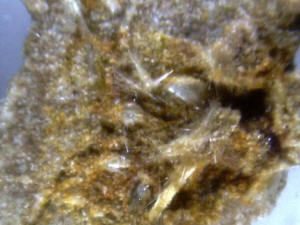 [1]%20brn%20alg%20HH.jpg) |
|
Little White Growths: Syconoid Sponges --
6/22/10
Hello,
<Hello Val, Lynn here today.>
I'm fairly new to the hobby and fell headlong into it. I can
sit there for hours and look at all the life in there!
<Ah, a kindred soul!>
Anyways, I'm at a loss in identifying the following organism.
I've been through your website, which is a bottomless pit of
valuable information (thank you), and I haven't found any
mention or photograph of this.
<They're there; you just have to know where to look and
granted a sponge isn't normally the first thing that comes to
people's minds when they see these things!>
The organisms in question are round or oval, attached at the
base, varying from 2-10mm in width. They have an opening at the
opposite end to where they are attached. My first thoughts were
egg pods, but now I'm not sure.
<They do look a bit like egg capsules of some sort, but
they're actually harmless, filter feeding, sponges in the
genus Sycon (aka Syconoid, pineapple, or Q-tip sponges). They
tend to appear in great numbers in new systems then dwindle to a
few here in there, usually within filters, sumps or around the
dimmer areas of the main tank. For more information and photos
for comparison, please enter the term Syconoid in our Google
search engine: http://www.wetwebmedia.com/Googlesearch.htm
>
50 gal tank contains: 1 Hippo tang, 1 yellow tang,
<These two will get crowded and stressed in a hurry in this
size tank which can lead to aggression and increased
susceptibility to disease.>
2 percula clowns, 1 PJ Cardinal, 2 cleaner shrimp, colony of
button polyps, star polyps and Kenya tree. 2 strawberry tip
snails, bumblebee snails and Asterinid snails, blue-legged
hermits and 2 porcelain crabs.
All parameters are normal, except perhaps slight phosphate levels
that are now in check.
<Good>
Any help is appreciated, thanks a lot and keep up the good
work
<You're very welcome, and thank you!>
Val Bourque
Memramcook, NB, Can
<Take care, Lynn Z >
|
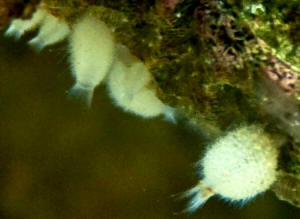 |
|
Was: half-black angel question, now HHs
6/15/10
Hi crew,
<L>
I wanted to send an update on the fouling of our tank last fall
(original message attached below). To recap, we went on vacation
and our automatic feeder was a bit too much of an overachiever
than we would have liked,
causing an ammonia surge and killing many of our critters. We
quarantined the survivors, a Yellow-tail Damsel, Sand Sifting Sea
Star, Turbo snail, and Hermit crab.
It is now 9 months later and 3 of 4 have survived (the sea star
mysteriously disappeared into the sand never to be heard from
again--we will not be buying another now that we know likely
course of life in captivity with "small" tank and
insufficient sand). All of the remaining survivors are doing
splendidly and were put back in the DT after it re-cycled.
<Ah good>
We have continued with our hobby (obsession?) and continue to
read as much as is palatable.
<Do chew between bites!>
Recently, we bought a few more pounds of LR and discovered the
animals shown in the attached pictures. From what I can tell, the
first pic shows a Chiton of some variety, the second a brittle
star (with cleverly hiding anemone--Aiptasia I think--at the
bottom),
<Yes, yes and likely so; an anemone of some sort at
least>
the third and fourth pics are closer shots of the anemone, and
the fifth pic is a close-up shot of the star (I have yet to find
out specific species).
There are also a handful of smaller Aiptasia that are lighter in
coloration scattered along the underside of that particular piece
of LR. I believe there may be a Peppermint shrimp in our
future.
<A good choice>
I have no pressing questions, just wanted to share the update and
thank you again for your site.
Regards,
Lance
<Thank you for the update Lance. BobF>
|
 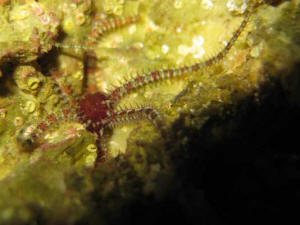 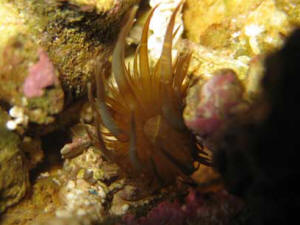 |
|
LR Hitchhikers 5/28/10
Greetings and salutations,
<What is it about stating over and over for folks to limit
their attachments to "a few hundred Kbytes" that is so
hard to comply with?>
Awesome site. I've spent many hours reviewing and reading the
tons of information you provide and it's really helpful.
<Evidently not the instructions on writing us James>
The only thing I haven't been able to find is the identity of
three hitchhikers that came along with some live rock I purchased
from a local saltwater fish store. The first one I need
identified is resting on the sand in the bottom right corner of
the attached photo. It looks to some type of clam but I've
been unable to find anything resembling it on your site or
anywhere else online.
<A clam of some sort.... PLEASE take and send individual
images of appropriate size of what you have in mind>
I bought it along with some LR believing it was just a piece of
dead coral and was rather surprised to see it close its shell a
couple days after adding it to my tank.
The other two specimen are attached to the top portion of the
"clam's" shell. I believe the large red, leaf-like
plant is some type of macro algae, but still would like to know
it's true identity and if it's harmful or not. My guess
is it's not harmful as it's not caused any problems so
far.
<Is a Red... Rhodophyte... maybe a Fauchea sp.>
The last one looks like some type of mushroom or sponge-like
growth just underneath the "macro algae".
<Mmm... maybe another algae>
Although it's growth is not symmetrical like a mushroom. Last
think I need to know is if either of these two specimen pose any
problems for the "clam" or whatever it is.
<Doubtful>
<GRIN> Thanks in advance for your outstanding support and
assistance.
<Bob Fenner>
Re: LR Hitchhikers 5/28/10
Bob,
<James>
My apologies. I did read the instructions but forgot to crop the
photo before attaching and sending. Here's the cropped photo
weighting in at 366kb and IAW the rules.
Thanks for the assistance.
James
<Thank you. BobF>
|
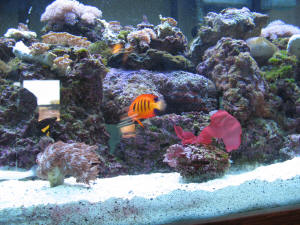 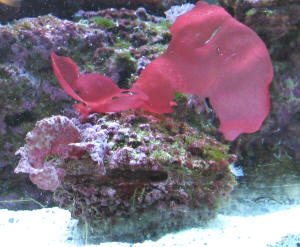 |
|
Re: LR Hitchhikers 5/28/10
Hi Bob,
<Neale>
That clam is either Spondylus or Chama. The latter is sometimes
called the "jewel box clam", the former is the
"spiny oyster" despite being a type of scallop. I kept
both during the 80s, and the Chama lasted years, eventually being
returned to the shop when we broke down the marine aquarium. The
Spondylus wasn't so lucky, though I still use its shell to
the present day as a nesting site for gobies!
<Ah yes... have done quite a bit of collecting (for food) with
the local Spondylus... and some science for the predominant
Cortez species...>
For the benefit of your correspondent, Spondylus has a few
spoon-like spines that trap algae and sponges, hence its Latin
name. Chama has dozens if not hundreds of shorter spines bunched
together almost like ruffles. Both are cemented to rocks or other
hard grounds.
Cheers, Neale
<Will accrue. B>
Re: LR Hitchhikers 5/28/10
Are they good? I used to find fossil Spondylus quite a lot on my
post-doc work -- but after 100 million years there's nothing
other than a handy source of calcium carbonate!
Cheers, Neale
<Oh, yes, to eat and the shells can be very nice as well.
B>
Re: LR Hitchhikers 5/28/10
> Are they good? I used to find fossil Spondylus quite a lot
on my post-doc work -- but after 100 million years there's
nothing other than a handy source of calcium carbonate!
> Cheers, Neale
<As with all the shellfish I've had occasion to sample,
the cool to coldwater species are "tastier" to my
palate than the warmer/tropical ones... That being stated, the
means through which they're prepared is definitely of
matter... Am not a big fan of "fried", particularly
deep... methods. But just "cooked" by citrus and a bit
of nut flake (there are several) and maybe a drop or two of
sesame oil and seed... Either singly or mixed with other seafood
bits, fresh tomato, onion, cilantro... Eeeyum! B>
|
|
Unidentified Hitchhiker 5/19/10
Hello,
<Hi there>
I recently bought a Ricordea frag that has some tubeworms and
some kind of pink stuff growing on it, but the question I have is
about a little blue guy, seen in the attached photo.
<Neat! Nice pic>
I scraped away the Ricordea it is butting against in the photo,
and shot some diluted phytoplankton at it. Today, it looks like
it may be growing.
There are darker blue spots between the yellow half-moon shapes
on the tip of the large polyp, and it looks like it may be
splitting.
It is probably less than half an inch long, and translucent. It
looks like the inside is a threaded or ribbed tube. Its stem is
shrouded in a fleshy translucent tan blanket. It's soft, and
reacts to touch and feeding.
Any help identifying Mr. Blue would be appreciated.
<This is almost assuredly an Ascidian... a Sea Squirt... Not
harmful... indeed, testament to the good care all have lavished
on the Ricordea over time. Read here re: http://wetwebmedia.com/ascidfaqs.htm
and the linked files above. Cheers, Bob Fenner>
|
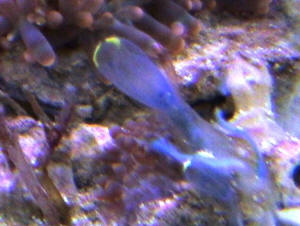 |
|
Re: Unidentified Hitchhiker, Asc. 5/20/10
Cool, thanks a ton!
<Welcome in kind, measure. B>
|
|
A Substance That Looks Like Mold 5/18/10
<Hello Matthew>
I have a 150gal reef tank with a fuge and 90lbs of live rock and
have recently been more and more curious about this growth on one
of my rocks, also close to this growth is a group of what looks
like sea vases.
<The only thing I see is the small colony of Xenia coral. Is
this what you are referring to?>
Please let me know what you think of these thanks in advance. I
have followed your website with great awe and interest on your
vast knowledge and would like to bring this question to only the
experts, this is my first post but am expecting criticism.
<The mold growth appears to be sponge
growth.><<Agreed. RMF>>
In the 1st pic(102_1152) there is some type of worm not a bristle
worm but is greyish and looks like 4in when it comes out of the
rock but have not seen it completely come out so actual length is
unknown.
<Likely a Nematode of some time, should cause no problem.
Thanks in advance
<You're welcome. James (Salty Dog)>
Matt
|
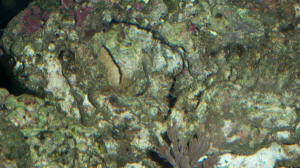  |
|
Re A Substance That Looks Like Mold 5/18/10
5/20/10
Thank you for your quick and courteous reply.
<You're welcome.>
I am not referring to the Xenia coral I was actually referring to
a worm like thing right above the Xenia in the crevice and the
other tunicates I was referring to are just to the left of the
sponge. Do you know of anything that will eat Dinoflagellates,
...
<and may want to read here and related articles/FAQ's
located in the header.
http://www.wetwebmedia.com/plantedtkssubwebindex/algcontags.htm
James (Salty Dog)>
|
|
|

